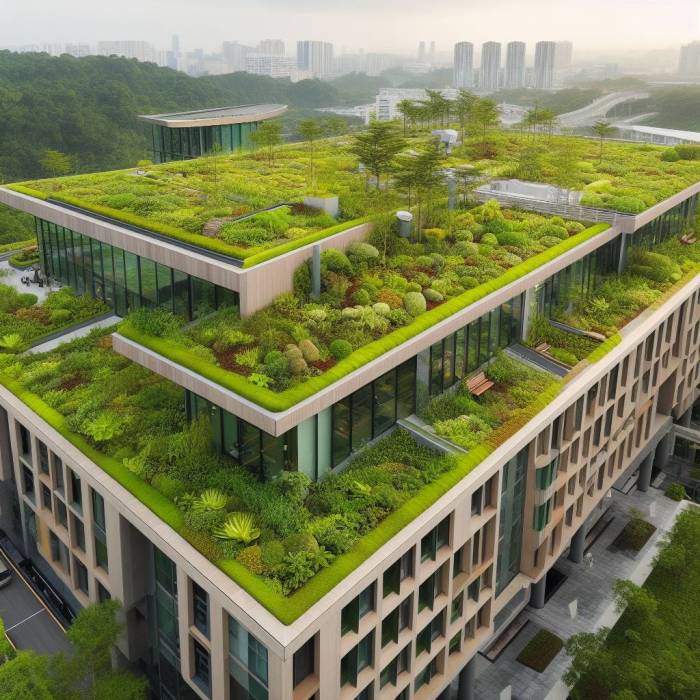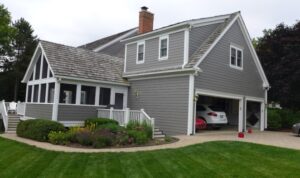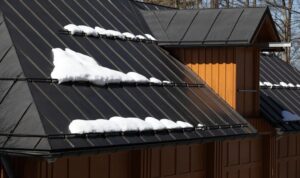Exploring the realm of green roofing systems for urban homes unveils a world where sustainability meets modern living. From eco-friendly benefits to innovative solutions, this topic delves into the essence of creating a greener urban landscape.
As we navigate through the different types, installation process, maintenance tips, and environmental impacts, a holistic picture emerges, showcasing the transformative power of green roofs in our cities.
Benefits of Green Roofing Systems
Green roofing systems offer a range of benefits that make them a valuable addition to urban homes. From environmental advantages to energy-saving benefits, here are some reasons why incorporating green roofs can be advantageous.
Environmental Advantages
- Reduction of urban heat island effect: Green roofs help to lower the overall temperature in cities by absorbing heat and providing natural cooling.
- Improved air quality: Plants on green roofs filter pollutants and carbon dioxide from the air, leading to cleaner and healthier urban environments.
- Biodiversity promotion: Green roofs provide habitats for birds, insects, and other wildlife, contributing to urban biodiversity conservation.
Energy-Saving Benefits
- Insulation properties: Green roofs act as natural insulators, reducing the need for heating and cooling systems in buildings, thus lowering energy consumption.
- Reduced energy bills: By regulating indoor temperatures more effectively, green roofs can lead to significant savings on energy bills over time.
- Extended roof lifespan: The protective layer of vegetation on green roofs helps to shield the underlying roof membrane from UV radiation and temperature fluctuations, extending the roof's lifespan.
Cost Savings
- Lower maintenance costs: Green roofs require less maintenance compared to traditional roofs, leading to long-term cost savings for homeowners.
- Increased property value: Homes with green roofs are often more attractive to buyers and can command higher selling prices, providing a return on investment for homeowners.
- Stormwater management: Green roofs can help to reduce stormwater runoff, potentially lowering costs associated with drainage infrastructure and water treatment.
Types of Green Roofing Systems

Green roofing systems come in various types, each offering unique benefits and features suitable for urban homes. Let's explore the different options available:
Extensive vs. Intensive Green Roof Systems
Extensive green roofs are lightweight and low maintenance, typically featuring a thin layer of soil and drought-resistant plants. These systems are ideal for urban homes looking for a cost-effective and sustainable roofing solution. On the other hand, intensive green roofs involve a thicker layer of soil and a wider variety of plants, including trees and shrubs.
While more complex and requiring regular maintenance, intensive green roofs offer additional green space and recreational opportunities for homeowners.
Modular Green Roofing Systems
Modular green roofing systems consist of pre-planted modules that can be easily installed and replaced, making them a convenient option for urban homes. These systems are versatile and can be customized to fit different roof shapes and sizes. Additionally, modular green roofs help improve insulation, reduce stormwater runoff, and enhance biodiversity in urban areas.
Installation Process
When it comes to installing a green roofing system on urban homes, there are specific steps that need to be followed to ensure its effectiveness and longevity.
Preparing the Roof Structure
Before installing a green roof, it is essential to prepare the roof structure properly to support the added weight and ensure proper drainage. Here are some tips for preparing the roof structure:
- Inspect the roof for any existing damage or leaks and repair them before proceeding with the installation.
- Ensure that the roof can support the additional weight of the green roof system, including the soil, plants, and other components.
- Install a waterproof membrane to protect the roof from water damage and leaks.
- Create proper drainage systems to prevent water buildup on the roof, which can cause structural damage over time.
- Consider adding a root barrier to prevent plant roots from penetrating the roof and causing damage.
Professional Installation vs. DIY Approaches
While some homeowners may attempt to install a green roof system themselves, it is highly recommended to hire professionals for the job. Here's why:
- Professional installers have the necessary experience and expertise to ensure that the green roof is installed correctly and efficiently.
- They can help determine the best type of green roof system for your specific needs and climate conditions.
- Professional installation often comes with warranties and guarantees, providing peace of mind for homeowners.
- DIY approaches can lead to costly mistakes and improper installation, which can result in leaks, structural damage, and other issues down the line.
- Overall, investing in professional installation for your green roof system is a wise choice to ensure its long-term success and performance.
Maintenance and Care
Green roofing systems require regular maintenance to ensure their longevity and effectiveness in providing environmental benefits, energy savings, and aesthetic appeal to urban homes. Proper care and attention are essential to prevent issues and maximize the benefits of a green roof.
Regular Inspections
- Perform regular inspections of the green roof to check for any signs of damage, such as leaks, plant overgrowth, or clogged drainage systems.
- Remove debris, fallen leaves, and other organic matter that can accumulate on the roof and block drainage pathways.
- Check the vegetation for signs of stress, such as discoloration or wilting, and address any issues promptly to prevent further damage.
Watering and Fertilization
- Monitor the moisture levels of the green roof to ensure that the plants are receiving adequate water, especially during dry periods.
- Fertilize the vegetation as needed to promote healthy growth and prevent nutrient deficiencies that can affect plant health.
- Avoid overwatering, as excessive moisture can lead to root rot and other issues that may compromise the integrity of the green roof.
Repair and Maintenance Work
- Address any leaks or structural damage promptly to prevent water infiltration and protect the building from potential water damage.
- Trim and prune the vegetation regularly to prevent overgrowth and maintain the aesthetics of the green roof.
- Ensure that the drainage system is functioning properly to prevent water buildup and potential structural issues.
Professional Maintenance Services
- Consider hiring professional maintenance services to conduct thorough inspections and maintenance work on your green roof, especially for larger or more complex systems.
- Consult with experts in green roof maintenance to develop a customized maintenance plan that meets the specific needs of your green roof.
- Regularly communicate with maintenance professionals to address any concerns or issues that arise and ensure the long-term health of your green roof.
Environmental Impact
Green roofing systems play a crucial role in enhancing urban biodiversity, mitigating urban heat island effects, and managing stormwater in urban areas.
Contribution to Urban Biodiversity
Green roofs provide habitats for birds, insects, and other wildlife in urban areas where natural green spaces are limited. By incorporating greenery into urban landscapes, green roofs help increase biodiversity and support local ecosystems.
Mitigation of Urban Heat Island Effects
Green roofs help reduce the heat island effect in urban areas by absorbing and deflecting solar heat, lowering ambient temperatures, and decreasing the need for air conditioning. This not only improves the comfort of urban residents but also reduces energy consumption and greenhouse gas emissions.
Impact on Stormwater Management
Green roofs help manage stormwater in urban areas by absorbing rainwater, reducing runoff, and alleviating pressure on municipal drainage systems. This helps prevent flooding, erosion, and water pollution, contributing to a more sustainable urban environment.
Last Word
In conclusion, green roofing systems offer more than just energy efficiency - they represent a step towards a greener, more sustainable future. By embracing these systems, urban homes can not only reduce their environmental footprint but also create a healthier and more vibrant community for generations to come.
FAQs
Are green roofs only beneficial for the environment?
While green roofs do provide significant environmental benefits, such as reducing urban heat island effects and managing stormwater, they also offer energy-saving advantages and potential cost savings for homeowners.
What are the main differences between extensive and intensive green roof systems?
Extensive green roofs are lighter and easier to install, typically featuring low-maintenance vegetation. In contrast, intensive green roofs are more complex, with a wider variety of plants and require more maintenance.
How can I troubleshoot common issues with my green roof?
Common issues like leaks or plant overgrowth can be addressed by inspecting the roof regularly, maintaining proper drainage, and seeking professional assistance if needed.






